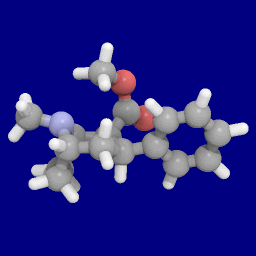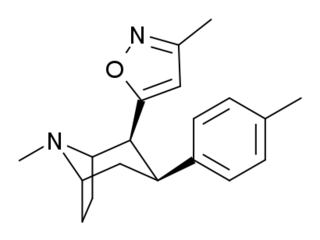
WIN 35,428 is a stimulant drug used in scientific research. CFT is a phenyltropane based dopamine reuptake inhibitor and is structurally derived from cocaine. It is around 3-10x more potent than cocaine and lasts around 7 times longer based on animal studies. While the naphthalenedisulfonate salt is the most commonly used form in scientific research due to its high solubility in water, the free base and hydrochloride salts are known compounds and can also be produced. The tartrate is another salt form that is reported.

Phenyltropanes (PTs) were originally developed to reduce cocaine addiction and dependency. In general these compounds act as inhibitors of the plasmalemmal monoamine reuptake transporters. This research has spanned beyond the last couple decades, and has picked up its pace in recent times, creating numerous phenyltropanes as research into cocaine analogues garners interest to treat addiction.

Troparil is a stimulant drug used in scientific research. Troparil is a phenyltropane-based dopamine reuptake inhibitor (DRI) that is derived from methylecgonidine. Troparil is a few times more potent than cocaine as a dopamine reuptake inhibitor, but is less potent as a serotonin reuptake inhibitor, and has a duration spanning a few times longer, since the phenyl ring is directly connected to the tropane ring through a non-hydrolyzable carbon-carbon bond. The lack of an ester linkage removes the local anesthetic action from the drug, so troparil is a pure stimulant. This change in activity also makes troparil slightly less cardiotoxic than cocaine. The most commonly used form of troparil is the tartrate salt, but the hydrochloride and naphthalenedisulfonate salts are also available, as well as the free base.

(–)-2β-Carboisopropoxy-3β-(4-iodophenyl)tropane is a stimulant drug used in scientific research, which was developed in the early 1990s. RTI-121 is a phenyltropane based, highly selective dopamine reuptake inhibitor and is derived from methylecgonidine. RTI-121 is a potent and long-lasting stimulant, producing stimulant effects for more than 10 hours after a single dose in mice which would limit its potential uses in humans, as it might have significant abuse potential if used outside a medical setting. However RTI-121 occupies the dopamine transporter more slowly than cocaine, and so might have lower abuse potential than cocaine itself.

Dichloropane ((−)-2β-Carbomethoxy-3β-(3,4-dichlorophenyl)tropane, RTI-111, O-401) is a stimulant of the phenyltropane class that acts as a serotonin–norepinephrine–dopamine reuptake inhibitor (SNDRI) with IC50 values of 3.13, 18, and 0.79 nM, respectively. In animal studies, dichloropane had a slower onset and longer duration of action compared to cocaine.

Altropane is a phenyltropane derivative which acts as a potent dopamine reuptake inhibitor and long-acting stimulant drug. It has mainly been used as the 125I radiolabelled form for mapping the distribution of dopamine transporters in the brain, and consequently this has led to its development as a potential diagnostic tool for early detection of Parkinson's disease. It is also being investigated for potential use in the diagnosis and treatment of attention deficit hyperactivity disorder (ADHD).

RTI(-4229)-150, is a phenyltropane derivative which acts as a potent dopamine reuptake inhibitor and stimulant drug. It is around 5x more potent than cocaine, but is more selective for the dopamine transporter relative to the other monoamine transporters. RTI-150 has a fast onset of effects and short duration of action, and its abuse potential in animal studies is similar to that of cocaine itself; its main application in scientific research has been in studies investigating the influence of pharmacokinetics on the abuse potential of stimulant drugs, with the rapid entry of RTI-150 into the brain thought to be a key factor in producing its high propensity for development of dependence in animals. RTI-150 is not explicitly illegal anywhere in the world, but its similar structure and pharmacological activity to cocaine makes it possible that it would be considered a controlled substance analogue in countries such as the US, Canada, Australia and New Zealand which have controlled substance analogue legislation.

RTI-126 is a phenyltropane derivative which acts as a potent monoamine reuptake inhibitor and stimulant drug, and has been sold as a designer drug. It is around 5 times more potent than cocaine at inhibiting monoamine reuptake in vitro, but is relatively unselective. It binds to all three monoamine transporters, although still with some selectivity for the dopamine transporter. RTI-126 has a fast onset of effects and short duration of action, and its pharmacological profile in animals is among the closest to cocaine itself out of all the drugs in the RTI series. Its main application in scientific research has been in studies investigating the influence of pharmacokinetics on the abuse potential of stimulant drugs, with its rapid entry into the brain thought to be a key factor in producing its high propensity for development of dependence in animals.

RTI(-4229)-336, is a phenyltropane derivative which acts as a potent and selective dopamine reuptake inhibitor and stimulant drug. It binds to the dopamine transporter with around 20x the affinity of cocaine, however it produces relatively mild stimulant effects, with a slow onset and long duration of action. These characteristics make it a potential candidate for treatment of cocaine addiction, as a possible substitute drug analogous to how methadone is used for treating heroin abuse. RTI-336 fully substitutes for cocaine in addicted monkeys and supports self-administration, and significantly reduces rates of cocaine use, especially when combined with SSRIs, and research is ongoing to determine whether it could be a viable substitute drug in human cocaine addicts.

RTI(-4229)-113 is a stimulant drug which acts as a potent and fully selective dopamine reuptake inhibitor (DRI). It has been suggested as a possible substitute drug for the treatment of cocaine addiction. "RTI-113 has properties that make it an ideal medication for cocaine abusers, such as an equivalent efficacy, a higher potency, and a longer duration of action as compared to cocaine." Replacing the methyl ester in RTI-31 with a phenyl ester makes the resultant RTI-113 fully DAT specific. RTI-113 is a particularly relevant phenyltropane cocaine analog that has been tested on squirrel monkeys. RTI-113 has also been tested against cocaine in self-administration studies for DAT occupancy by PET on awake rhesus monkeys. The efficacy of cocaine analogs to elicit self-administration is closely related to the rate at which they are administered. Slower onset of action analogs are less likely to function as positive reinforcers than analogues that have a faster rate of onset.

RTI(-4229)-112 is a synthetic stimulant drug from the phenyltropane family. In contrast to RTI-113, which is DAT selective, RTI-112 is a nonselective triple reuptake inhibitor.

RTI(-4229)-177 is a synthetic stimulant drug from the phenyltropane family, which acts as a DRI with micromolar affinity for the SERT. RTI-177 has an unusually long duration of action of 20 hours or more, substantially longer than the related compound RTI-336 from which it differs in molecular structure only by the absence of a p-methyl group.

(–)-2β-Carbomethoxy-3β-(4'-chlorophenyl)tropane (RTI-4229-31) is a synthetic analog of cocaine that acts as a stimulant. Semi-synthesis of this compound is dependent upon the availability of cocaine starting material. According to the article, RTI-31 is 64 times the strength of cocaine in terms of its potency to elicit self-administration in monkeys. WIN 35428 was 6 times weaker than RTI-31, whereas RTI-51 was 2.6 times weaker than RTI-31.

(–)-2β-Carbomethoxy-3β-(4-bromophenyl)tropane is a semi-synthetic alkaloid in the phenyltropane group of psychostimulant compounds. First publicized in the 1990s, it has not been used enough to have gained a fully established profile. RTI-51 can be expected to have properties lying somewhere in between RTI-31 and RTI-55. It has a ratio of monoamine reuptake inhibition of dopamine > serotonin > norepinephrine which is an unusual balance of effects not produced by other commonly used compounds. It has been used in its 76Br radiolabelled form to map the distribution of dopamine transporters in the brain.

3β-(4-Methylphenyl)-2β-[3-(4-chlorophenyl)isoxazol-5-yl]tropane (RTI-4229-371) is a phenyltropane derived drug which acts as a potent and selective dopamine reuptake inhibitor in vitro, yet unusually for this class of compound, both RTI-371 and the closely related compound RTI-370 failed to produce locomotor stimulation in mice. In addition to this, in drug substitution tests RTI-370 weakly generalized to cocaine whereas RTI-371 did not generalize at all.

RTI-229, also known as (–)-3β-(4-iodophenyl)tropane-2β-pyrrolidine carboxamide and RTI-4229-229, is a potent and long-lasting stimulant drug which was developed in the 1990s as part of a large group of related analogues from the phenyltropane family. With the combination of two potent dopamine transporter (DAT) binding motifs attached to the tropane ring, the p-iodophenyl group at the 3β-position and a pyrrolidine carboxamide at 2β, RTI-229 has extremely high selectivity for the dopamine transporter and is one of the most DAT-selective compounds in the RTI series.

(–)-2β-Carbophenoxy-3β-(p-tolyl)tropane (RTI-4229-120) is a phenyltropane derivative which acts as a reasonably selective dopamine reuptake inhibitor, along with weaker inhibition of noradrenaline and serotonin reuptake. It has a reasonably fast rate of occupancy of dopamine transporters in the brain, though slower than that of cocaine itself. RTI-120 has a short duration of action, along with other p-methyl substituted phenyltropanes such as RTI-150, RTI-171 and RTI-199, giving it a more similar pharmacological profile to cocaine compared to longer acting analogues like RTI-121 and RTI-177.

(–)-2β-(3-Methylisoxazol-5-yl)-3β-(p-tolyl)tropane (RTI-4229-171) is a phenyltropane derivative which acts as a selective dopamine reuptake inhibitor, with a relatively slow onset of action and short duration of effects found in animal studies. However, other studies have shown it to have the most pronounced effects in terms of speed of onset and rate of stimulation among many differing phenyltropanes.

RTI-83 is a phenyltropane derivative which represents a rare example of an SDRI or serotonin-dopamine reuptake inhibitor, a drug which inhibits the reuptake of the neurotransmitters serotonin and dopamine, while having little or no effect on the reuptake of the related neurotransmitter noradrenaline. With a binding affinity (Ki) of 55 nM at DAT and 28.4 nM at SERT but only 4030 nM at NET, RTI-83 has reasonable selectivity for DAT/SERT over NET




















